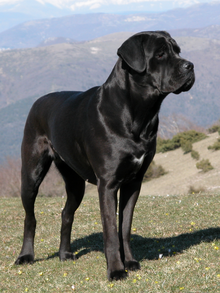Cane Corso
| Cane Corso | |||||||||||||||||
|---|---|---|---|---|---|---|---|---|---|---|---|---|---|---|---|---|---|
 | |||||||||||||||||
| Other names |
| ||||||||||||||||
| Origin | Italy | ||||||||||||||||
| |||||||||||||||||
| |||||||||||||||||
| Dog (domestic dog) | |||||||||||||||||
The Cane Corso[a] is an Italian breed of mastiff. It is usually kept as a companion dog or guard dog; it may also be used to protect livestock. In the past it was used for hunting large game, and also to herd cattle.
History
[edit]According to the breed standard of the Fédération Cynologique Internationale, the Cane Corso was once distributed throughout much of the Italian peninsula, but in the recent past was found only in Puglia, in southern Italy.[1][2] After the collapse of the mezzadria system of share-cropping in the 1960s, the dogs became rare. The modern breed derives from selective breeding from about 1980 of a few surviving animals.[3] A breed society, the Società Amatori Cane Corso, was formed in 1983.[4]: 107 [5] The breed was recognised by the Ente Nazionale della Cinofilia Italiana in 1994;[3] it was provisionally accepted by the Fédération Cynologique Internationale in 1996, and received full acceptance in 2007.[6] It was recognised by the American Kennel Club of the United States in 2010.[7]
In the period 2011–2019 the number of annual registrations in Italy was in the range of 3000–4250.[8]
Characteristics
[edit]The Cane Corso is a large dog of molossoid type, and is closely related to the Neapolitan Mastiff. It is well muscled[7] and less bulky than most other mastiff breeds. According to the international standard, dogs should stand some 62–70 cm at the withers and weigh 45–50 kg; bitches are about 4 cm smaller, and weigh some 5 kg less.[1]
The head is large, slightly over one third of the height at the withers in length, with a well-defined stop. The top of the cranium is flat and slightly convergent to the muzzle. The eyes are oval in shape, and set well apart. The iris of the eye should be as dark as possible.[2]
The coat is short, dense and lustrous. It may be black, various shades of grey (lead-grey, light grey or slate-grey) or fawn (dark fawn, light fawn, or stag red), or dark wheaten ('fromentino'); it may be brindled. Minor white markings on the chest, the feet or the nose are tolerated.[1][2]
The Cane Corso is genetically pre-disposed to elbow and hip dysplasia, to patellar luxation and to retinal dysplasia. It has above-average susceptibility to demodicosis, ectropion, entropion, gastric dilatation volvulus (bloat), hypothyroidism, idiopathic epilepsy, mycotic otitis and nictitans gland prolapse (cherry eye).[9]: 129
In 2017 a study of 232 Cane Corso dogs from 25 countries found an average life span of 9.3 years, varying with different coat colours. The longest-lived were black brindle (10.3 years), followed by: brindle (10.1 years); grey brindle (9.8 years); black, fawn and grey (all 9.0 years); and dogs of other colours (8.1 years).[10] A study of dogs in the United Kingdom, published in 2024, found an average life span for the breed of 8.1 years overall.[11] A 2024 Italian study found a life expectancy of 9 years for the breed compared to 10 years overall.[12]
Use
[edit]The Cane Corso is usually kept as a companion dog or guard dog; it may also be used to protect livestock. In the past it was used for hunting large game, and also to herd cattle.[8]
It is subject to a working trial: in order to qualify for registration, dogs must show tranquillity in the presence of inoffensive strangers, indifference to gunfire, and aggressive defence of the owner against an attacker.[1]: 2 [13]
-
Grey brindle
-
Brown brindle
-
Black brindle
-
Fawn
Notes
[edit]- ^ Italian: [ˈkaːne ˈkɔrso], plural: Cani Corsi
References
[edit]- ^ a b c d e f FCI-Standard N° 343: Cane Corso Italiano (Italian Cane Corso). Fédération Cynologique Internationale. Archived 13 August 2021.
- ^ a b c Cane Corso (in Italian). Ente Nazionale della Cinofilia Italiana. Accessed August 2021.
- ^ a b S.P. Marelli, A. Monaghé, M. Polli, L. Guidobono Cavalchini (2003). Body measurements and morphological evaluation of Italian Cane Corso. Italian Journal of Animal Science 2 (supplement): 88–90. doi:10.4081/ijas.2003.11675924. (subscription required).
- ^ Rino Falappi (2009). Cani: Conoscere, riconoscere e allevare tutte le razze canine più note del mondo (in Italian). Novara: Istituto Geografico De Agostini. ISBN 9788841854068.
- ^ Cane corso italiano (in Italian). Società Amatori Cane Corso. Archived 21 May 2021.
- ^ FCI breeds nomenclature: Cane Corso Italiano (343). Fédération Cynologique Internationale. Archived 5 July 2020.
- ^ a b Get to Know the Cane Corso. The American Kennel Club. Archived 19 May 2015.
- ^ a b Cane Corso (in Italian). Ente Nazionale della Cinofilia Italiana. Accessed August 2021.
- ^ Jerold S. Bell, Kathleen E. Cavanagh, Larry P. Tilley, Francis W.K. Smith (2012). Veterinary Medical Guide to Dog and Cat Breeds. Jackson, Wyoming: Teton NewMedia. ISBN 9781482241419.
- ^ Evžen Korec (2017). Longevity of Cane Corso Italiano dog breed and its relationship with hair colour. Open Veterinary Journal. 7 (2): 170–173. doi:10.4314/ovj.v7i2.15.
- ^ Kirsten M. McMillan, Jon Bielby, Carys L. Williams, Melissa M. Upjohn, Rachel A. Casey, Robert M. Christley (2024). Longevity of companion dog breeds: those at risk from early death. Scientific Reports. 14, article 531. doi:10.1038/s41598-023-50458-w.
- ^ Roccaro, Mariana; Salini, Romolo; Pietra, Marco; Sgorbini, Micaela; Gori, Eleonora; Dondi, Maurizio; Crisi, Paolo E.; Conte, Annamaria; Dalla Villa, Paolo; Podaliri, Michele; Ciaramella, Paolo; Di Palma, Cristina; Passantino, Annamaria; Porciello, Francesco; Gianella, Paola; Guglielmini, Carlo; Alborali, Giovanni L.; Rota Nodari, Sara; Sabatelli, Sonia; Peli, Angelo (2024). "Factors related to longevity and mortality of dogs in Italy". Preventive Veterinary Medicine. 225: 106155. doi:10.1016/j.prevetmed.2024.106155. hdl:11585/961937.
- ^ CAL (Certificato di attitudine al lavoro) (in Italian). Società Amatori Cane Corso. Archived 23 August 2021.




